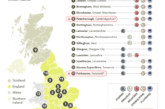 Emma Mahy, CEO of monitoring technology company IoT Solutions Group, discusses the Regulator of Social Housing’s recent report setting out the key damp and mould findings for social landlords and how monitoring technology can help landlords continually assess stock condition.
Emma Mahy, CEO of monitoring technology company IoT Solutions Group, discusses the Regulator of Social Housing’s recent report setting out the key damp and mould findings for social landlords and how monitoring technology can help landlords continually assess stock condition.
Released on the 28th June 2023, the final analysis and conclusions of the report into damp and mould in social housing are now available. Conducted by the Regulator of Social Housing, this report aims to assess the prevalence of damp and mould problems in over four million social housing properties. In the foreword of this report, Chief Executive of the Regulator for Social Housing, Fiona MacGregor, encourages housing teams to challenge their current practices: “I encourage boards, counsellors, and management teams to read [this report] carefully and ask themselves challenging questions about how they could make improvements to what they currently do. As well as tackling damp and mould issues, it is vitally important that landlords look at how they manage the condition and quality of the tenants’ homes in the round.”
Throughout the report, there is a clear focus on monitoring and evidencing stock condition. The overall findings show a “mixed but improving picture”. Governance, processes, operations and data systems are improving with some providers but were identified as weaknesses with others. Assessing and monitoring stock condition is a continual theme throughout the report, with a concluding comment stating that: “High quality, comprehensive and up-to-date stock condition information is the foundation of strong asset management. Landlords cannot improve the quality of the homes tenants live in if they do not know what condition they are in and what investment they need.”
Technology has enormous potential to deliver this vital stock condition data quickly, efficiently and economically, and therefore help deliver decent social housing. Newer technologies developed in collaboration with housing providers can now offer continual and automated damp, mould and fuel poverty risk detection and alerts for pence per day with minimal installation. These sensors’ targeted datasets deliver efficiencies and enable housing providers to respond to those most at risk.
Councils like Kingston have implemented Internet of Things remote monitoring sensors to “nip problems in the bud before they happened [and] to give [them] a bigger understanding of what is going on inside properties”. These sensors enabled the team to take a proactive approach so that preventative action could be taken quickly. They also used the sensors to monitor the impact of property improvements.
With the expectations placed upon landlords increasing and standards and regulations set to change in a matter of months, taking a proactive approach to stock condition data is more critical than ever. As well as assessing damp and mould risk, continual, automated temperature and humidity data can ensure the desired improvements from remedial works for tenants and landlords. Another benefit of proactive monitoring is assessing the most at-risk properties and different housing archetypes for prioritising remedial works.
In conclusion, the final analysis of the report on damp and mould in social housing highlights both the progress being made by social housing providers and areas for improvement. Accurate and timely stock condition data is crucial for effective asset management, and technology plays a key role in delivering this information efficiently. Proactive monitoring using modern sensors can quickly detect issues while prioritising remedial works, ensuring tenant well-being in this evolving regulatory landscape.










